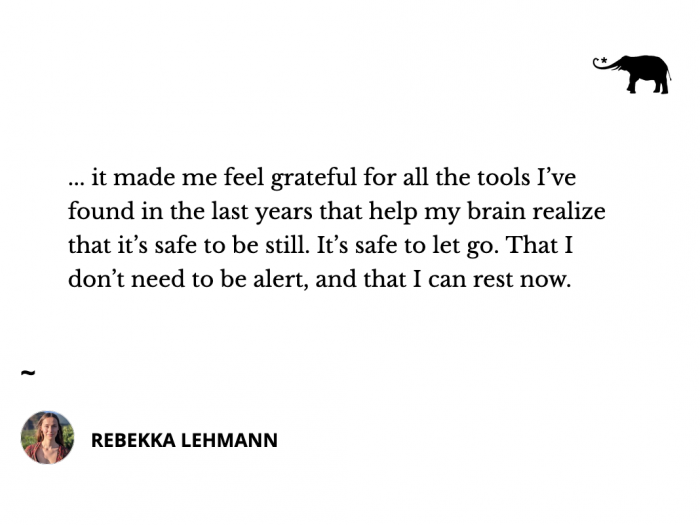View this post on Instagram
Last night, I had insomnia.
It had been a while since that happened, and I barely experience it anymore. But when I do, I usually know the reason for it: premenstrual syndrome (PMS), an upcoming deadline I’m trying to meet, or worries about my new business.
And it made me think of a time in my life when I didn’t have a clue why I couldn’t calm my mind, or how to do so.
It made me reflect on how, as a five-year-old, I’d be the only kid in the nursery group who couldn’t nap but lay there on my tiny makeshift mattress, staring at the ceiling, waiting for the others to wake up.
It reminded me of how, when I was in primary school, I’d lie awake in the evenings, twisting a strand of hair, the one closest to my forehead. How I’d then shove it upward, as if to make a dreadlock, and, eventually, pull it out.
It made me think of how, when I was a teenager, I’d lie awake for at least an hour every night, thinking, tossing, turning, worrying about things I shouldn’t have to worry about.
And, lastly, it made me feel grateful for all the tools I’ve found in the last years that help my brain realize that it’s safe to be still. It’s safe to let go. That I don’t need to be alert, and that I can rest now.
In hindsight, I see how my inability to calm my mind was a clear sign of how overwhelmed and anxious I felt during those times. I now know that sleep needs to be prioritized in my self-care because it’s crucial to fight stress.
And while I was lacking the proper tools for many years, I have found a few of them, and I want to share them with you.
Even though I still suffer from insomnia occasionally, the following practices have helped me tremendously. And perhaps they’ll be of benefit to you, too.
1. Being mindful about lights
Lights play a crucial role in regulating one of our body’s internal rhythms: the circadian rhythm. This system signals our bodies when to rest and when to be alert. It also has an effect on the production of melatonin—an essential hormone when it comes to sleep.
Keeping the lights dim in the evening and using warm color temperature can help our nervous systems prepare for a good night’s sleep.
I also found it important to pay attention to blue light sources. Blue wavelengths seem to be most disruptive to the circadian rhythm and have negative effects on our sleep patterns.
Blue light is present in any bright screens we’re using, so it’s helpful to avoid them before going to bed. Turning off my phone and laptop at least one hour before going to bed made a great difference for me personally. There are apps for phones and laptops that gradually filter out blue light. Some devices already have this function in the settings. For others, one program that I can recommend and that works well on different operating systems is called f.lux.
2. Having an evening ritual
Finding a personal evening ritual that helps me wind down was a game changer for me.
Here’s an example of how this can look like:
After turning off my phone and laptop, I take a shower, change into my comfy pajamas, and read on the couch. Once I get tired, I journal down a few thoughts and feelings of the day and anything I noticed about my cycle. Lastly, I spend a few minutes of quality time together with my partner, cuddling before I fall asleep.
Since each of us has different preferences, here are some other examples:
>> A short meditation
>> Relaxation techniques like progressive muscle relaxation
>> Evening yoga
>> Cuddling with your pet
It took me a while to understand what I need, so be patient and try out different things until you find what works best for you.
3. Practicing “horsy lips”
Stress and tension in the jaw are the reason a lot of people gnash their teeth at night (I used to do it, too), potentially interrupting our sleep.
If you’re one of those people, start by finding a comfortable position. Exhale all the way through your nose, soften your jaw and the back of your tongue. Now, breathe in deeply through your nose. With your next exhale, breathe out while relaxing your jaw and flutter your lips. Do this several times until you feel the tension in your jaw melt away. You can deepen this by massaging your cheeks and jaw muscles with your fingertips before or after you fluttered your lips.
You may do this practice anytime during the day or before going to bed at night.
4. Ending the day with gratitude
I mentioned that I often spend a few minutes with my partner before falling asleep. During that time, we regularly talk about our top three moments of the day to help our mindsets shift away from our to-dos and toward gratitude.
Of course, we don’t need a partner to do this. We can simply write it down in a journal.
Our top three can be three moments of the day we feel most grateful for, the three people in our life we appreciated the most on that day, the three things we’re thankful for in ourselves and want to celebrate, or anything else.
Be specific about whatever it is you describe.
As sometimes it can be hard to come up with even one thing, consider even the most simple things in your life: a nourishing breakfast, the warm apartment during winter, or a yummy cup of tea.
5. Focusing on the breath
While I know many meditation teachers who are strict about trying not to fall asleep while meditating, I propose that there actually is a time and place for that.
Whenever I feel my mind wanders while I’m lying in bed, I try to focus on my breath. My thoughts may agitate me, which is the opposite of what I need at that moment. It took me a while to make this work, but focusing my attention on my breath helps me fall asleep a lot faster.
Here’s a short instruction to get you started:
As you lie in your bed, you may notice your mind going to different places. Perhaps you’re thinking about something that happened in the past or worrying about the future.
When that happens, simply notice it. You may label it “thinking” and bring your attention to your breath.
There’s no need to change your breath. Just observe how, as you inhale, the air enters your nose and fills up your belly. As you exhale, your belly falls and the air passes your nostril once again. Inhale and exhale.
When your mind begins to wander again, notice it with a sense of acceptance.
You may be surprised how long it takes for you to notice that it wandered. That’s completely okay. Again, label it “thinking,” and simply come back to your breath. Coming back to the breath is the practice.
Notice your inhalation and your exhalation.
Continue this practice for as long as needed.
If you have any nighttime rituals or practices that work for you, I invite you to add them in the comments. Perhaps, they’ll be of benefit to someone.











Read 4 comments and reply